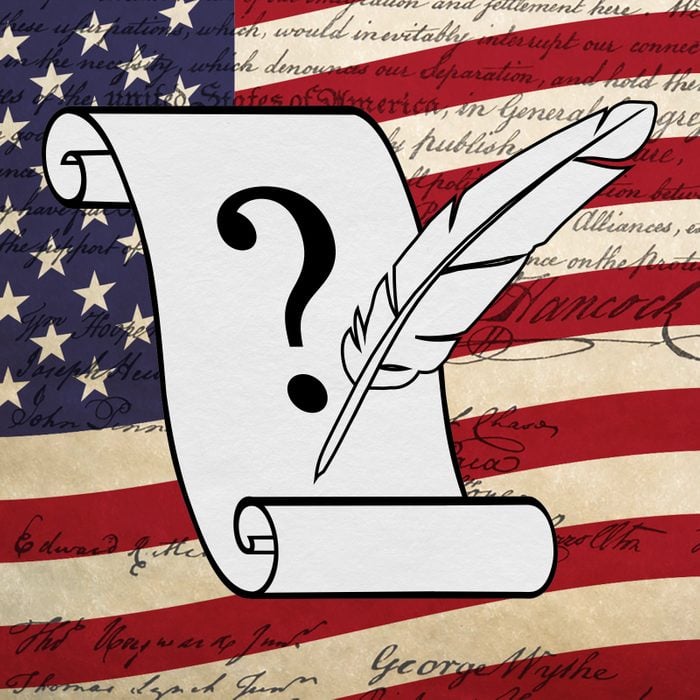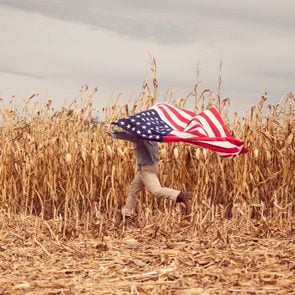How Many Signatures Are on the Declaration of Independence?
Updated: Nov. 22, 2022

This document contains the signatures of John Hancock, Thomas Jefferson, and Benjamin Franklin. So exactly how many signatures are there—and whose is most valuable?
The 4th of July is a day to celebrate America’s independence from Britain. Some people celebrate by sharing 4th of July quotes on social media, whereas others brush up on their Independence Day trivia to break out at the barbecue. If you really want to impress your Independence Day company (especially the history buffs), read up on facts about the Declaration of Independence—including interesting facts about the Declaration of Independence signatures.
Below, you’ll find interesting tidbits about those Founding Fathers’ signatures, including how many people actually signed the document and whose signature is most valuable (it may not be who you think!). After you read these interesting facts, read up on the difference between the Declaration of Independence and the Constitution.
When was the Declaration of Independence signed?
The Declaration of Independence was signed on August 2, 1776. Many people may assume it was signed on July 4, the day it was officially adopted by Congress, but it took nearly a full month to get the document signed. Some reasons include politics with the New York delegates, and the fact that it took about two weeks to be formally written on parchment paper.
How many signatures are on the Declaration of Independence?
Fifty-six men signed the Declaration of Independence in 1776. Some of them went on to become president (like John Adams and Thomas Jefferson). Others have museums, monuments, and even beers named after them.
Who has the most valuable signature on the Declaration of Independence?
Button Gwinnett is not one of the most famous signers, but his signature is the most valuable of the dozens on the Declaration of Independence.
In a surprising twist, it’s Gwinnett’s obscurity that makes his signature so much more valuable than those of the other signers. Button Gwinnett (yes, Button was his real name) was born in England in 1735. At age 30, he moved to the American colonies. Living in Georgia, he suffered through multiple failed business endeavors, which didn’t exactly make him a celebrity. Eventually, Gwinnett got into politics and became very passionate about the colonies’ independence. And sure enough, there he was in Independence Hall in 1776, signing that Declaration, below and to the left of John Hancock’s now-famous penmanship. And then, in 1777, he was killed in a duel with a political rival.
In the 1820s, very few signers of the Declaration were still alive, and history enthusiasts began searching for, and collecting, signatures of all 56 founding fathers. For the Declaration’s more well-known signers, signatures weren’t hard to find. Many of them were prominent politicians who had signed lots of documents in their day. Ben Franklin, in particular, wrote scores of letters. But that Button guy? Finding his signature wasn’t so easy.
Due to his life of obscurity, and its untimely end about a year after the act that made him famous, his signature was (and still is) the rarest of the 56, by far. According to History Buff, there are only 51 known signatures in existence by this forgotten Founding Father. And the fewer the signatures, the higher the value. According to Radiolab, the value of Gwinnett’s signature surpasses those of George Washington, Abraham Lincoln, and many other major historical figures. His signature’s value is considered to be up there with William Shakespeare’s. Not bad for someone who spent most of his life as a failed businessman! Check out these myths about the U.S. Constitution that most Americans believe.
In 2010, a Gwinnett signature sold for $722,500 in New York City. If you want to get a look at it for free, four copies currently reside at the New York Public Library. Or you can head to the National Archives in Washington, DC, to see the full Declaration in all its glory.
Whose signature was the most noticeable on the Declaration of Independence?
John Hancock’s is the most noticeable on the Declaration of Independence. Hancock was president of the Congress at the time of signing, and he signed the document first—with a very large, hard-to-miss signature. After all, there’s a reason his name is synonymous with “signature” today.
Written with contribution from Kelly Kuehn.
Sources:
- Dictionary.com: “John Hancock”
- History Buff: “The Most Valuable Signature on the Declaration of Independence Belongs to Someone You’ve Never Heard Of”
- Radiolab: “Buttons Not Buttons”
- The Atlanta Journal-Constitution: “Button Gwinnett signature fetches $722,500 at auction”
- History.com: “9 Things You May Not Know About the Declaration of Independence”
- National Geographic: “Signing of the Declaration of Independence”


